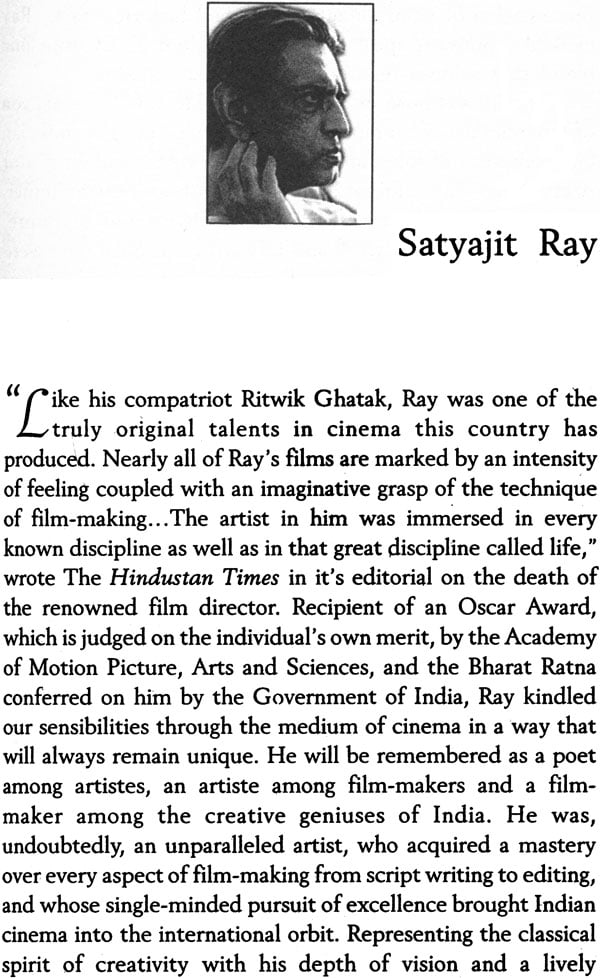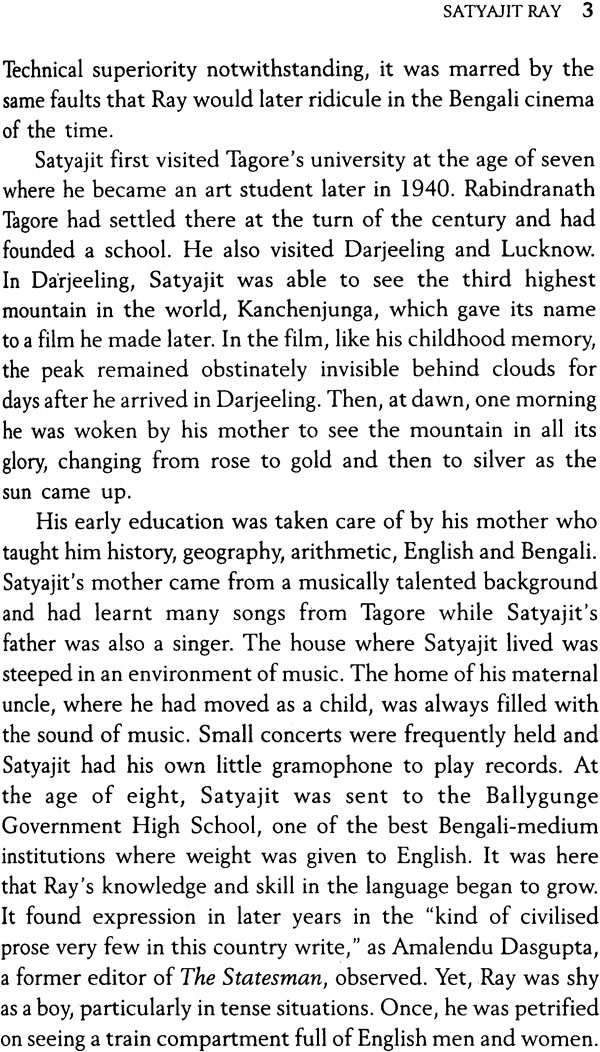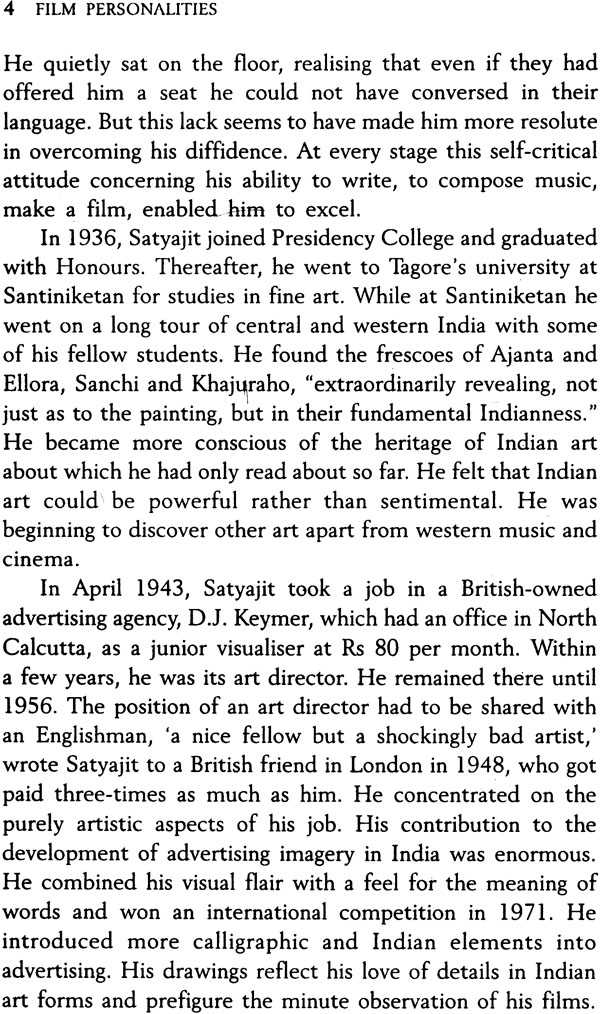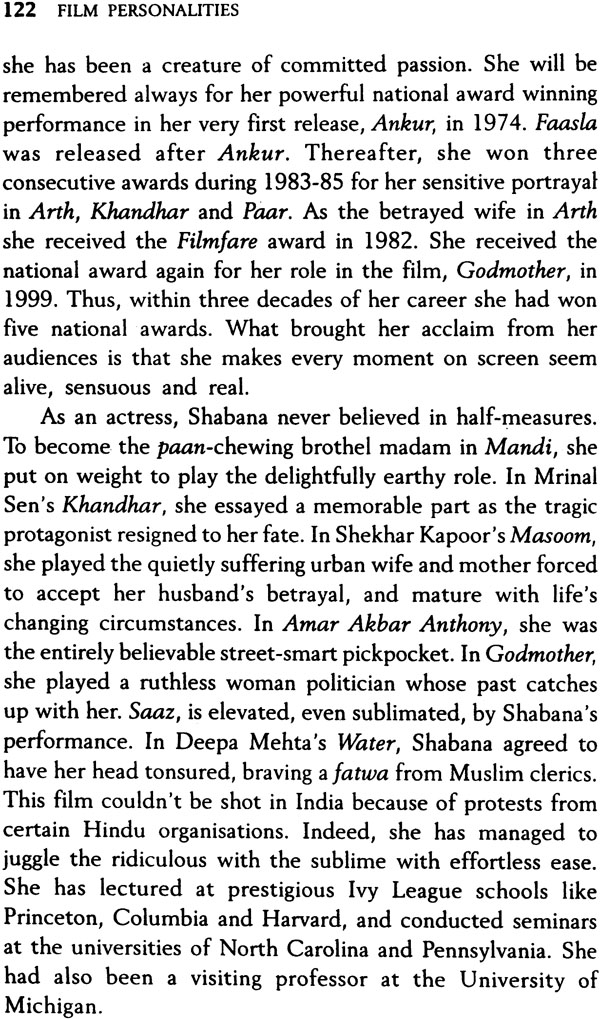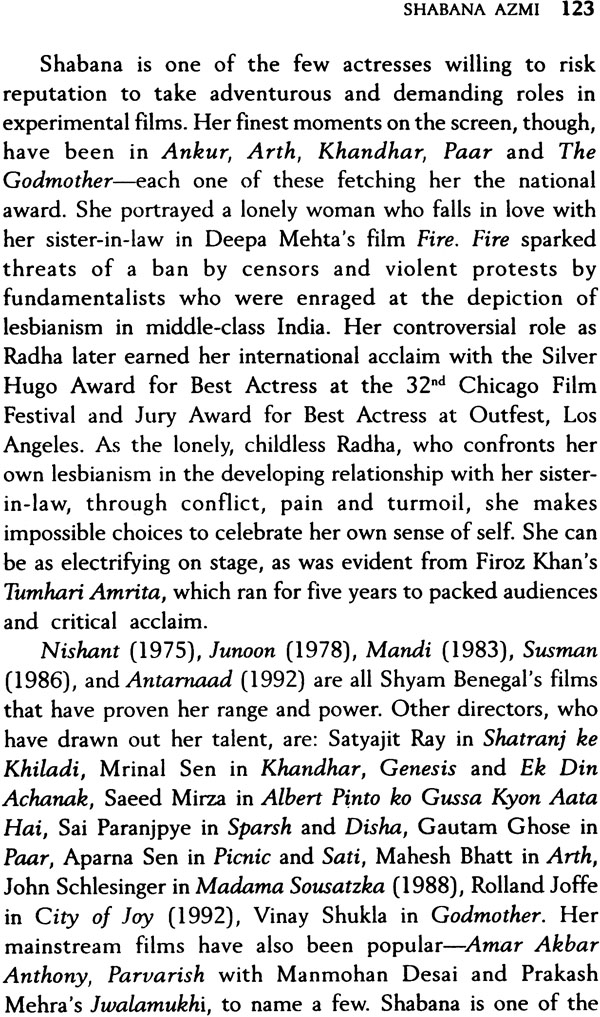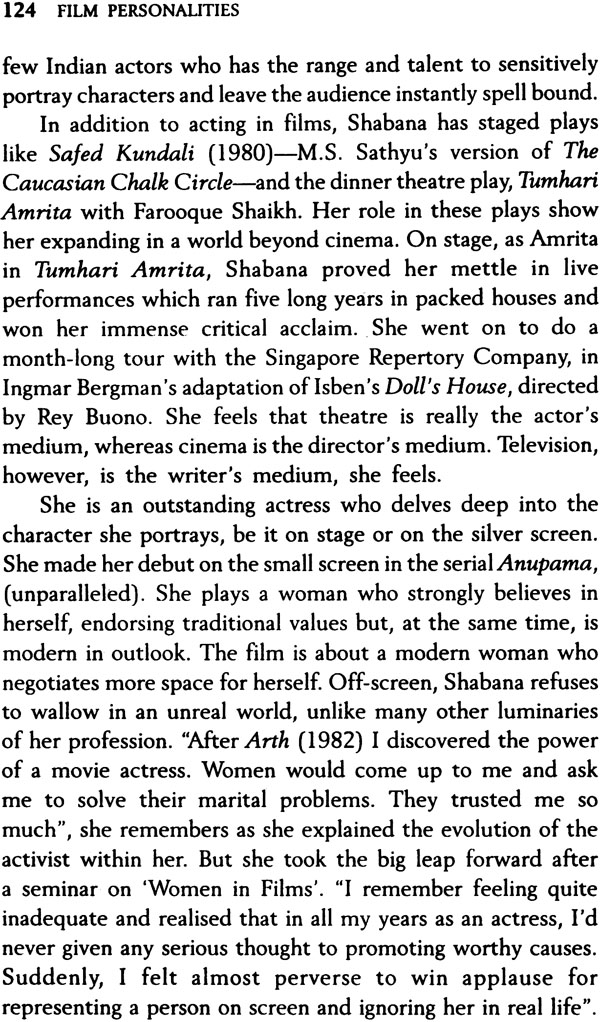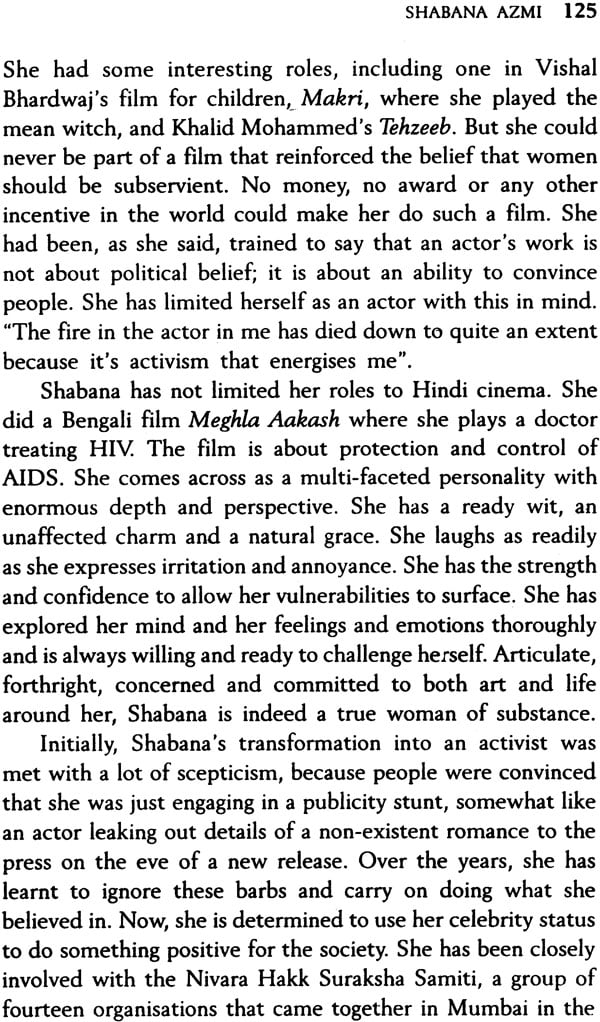
Eminent Indians Film Personalities
Book Specification
| Item Code: | NAF242 |
| Author: | M.L. Ahuja |
| Publisher: | Rupa Publication Pvt. Ltd. |
| Language: | English |
| Edition: | 2007 |
| ISBN: | 9788129111128 |
| Pages: | 146 (10 B/W Illustrations) |
| Cover: | Paperback |
| Other Details | 8.5 inch x 5.5 inch |
| Weight | 180 gm |
Book Description
Cinema is twentieth century’s definitive medium of mass communication. It has proved to be a mode of catharsis in resonating among the viewers the sentiments for transforming their perceptions. Starting from Raja Harishchandra (1913), the first indigenously made Indian feature film makers and actors have attempted to provide in their contemporary films plausible scenarios while entertaining over 3.5 million people on a daily basis.
This book eminent Indians: Film Personalities attempts to bring to focus the quintessence the development of Bollywood over the years and the success stories of ten persons who have made Indian cinema the most creative industry the world over.
Such distinguished persona include film-maker like Satyajit Ray who kindled our sensibilities through the medium of cinema; Mrinal Sen who experimented with new styles and techniques of film-making; Rajkapoor, whose brand of intense passion wrapped social message with undercurrents of tradition and modernity; M.G. Ramachandran who had an unparalleled success in the politics of Tamil Nadu and was an undisputed patron saint of the poor; and Shyam Benegal who has portrayed in his films the panoramic society of India and Its Potential.
Other personalities included in this book are: Amitabh Bachchan who has endeared himself as an icon playing almost every role with and equal elan Nargis, the epitome of grace who as a representative of her generation and a symbol of change was applauded as the First Lady of Indian cinema. Madhubala with her celestial beauty, bewildering smile and vivacious eyes projected depth of character and exercised a hypnotic power over the audience. Shabana Azmi is a contemporary actress who is a child of nature intuitive witty social activist and parliamentarian. Above all it is a useful book for all those interested in the development of Indian cinema and in knowing about the contributions of film personalities.
Recipient of Janseva sadbhavana Award (2006) and Bharat Gaurav Award (2007) M.L. Ahuja, M.A., DLL, DCS, is the author of over twenty book. He has travelled extensively both within and outside India and has presented a number of papers at several national and intentional seminars. He has also contributed a number of articles to journals and books, which are mostly on publishing or marketing of books and journals.
Cinema is the twentieth century’s definitive medium of mass communication. It binds together an astonishing mixture of cultures. It has proved a mode of catharsis millions by providing entertainment that absolves them of the responsibility that comes with action. The sociological impact of cinema as a medium of change cannot be underestimated. It is an interpretative art for critics and viewers alike. The universal appeal of cinema therefore is not only in viewing the magic of moving characters and their screen lives but also in the sentiments that resonate within the viewers while watching them. Raja Harishchandra (1913), the first indigenously made Indian feature film was just such an experience. Bollywood the Hindi film industry stated with this film. By the end of the century it had gorwn into a creative and financial monolith with the intervening decades witnessing technological innovations that were to change the face of the Industry. Today Bollywood the word was coined in the west to capture the scale and the glamour of the industry in comparison with Hollywood produces more than 100 film a year and entertains billions of people around the globe. The Indian film industry produces up to 800 films each year that are watched by 3.5 million people daily bringing each year that are watched by 3.5 million people daily bringing the weekly sale of tickets to the tune of over 100 million.
For almost two decades before Raja Harishchandra was premiered cinema had been in an embryonic stage. In the early 1890s magic lanterns showed a succession of sliders that were popular in Europe and American. In India Mahadev Gopal patwardhan created slider of sequences from the Ramayana and the birth of Lord Krishna experimented with the idea of making the characters appear to move and stated holding shows. Subsequently in France the Lumiere brothers created history by exhibiting short films for the first time to group of Chic Parisians in September 1895. Within a year of this event his exciting new invention had landed on Indian shores as the Lumiere brother made commercial use of their discovery. On 7 July 1896, the Lumiere cameraman Maurice Sestier held the first film screening in India at Mumbai Watson Hotel. Films were also exhibited with the Indian market in view. Some foreign film makers like professor Stevenson and Professor Anderson photographed shorts based of Indian themes such as A Panorama of Indian scenes and Train arriving at Bombay. In 1898, Mumbai based pioneer Saws Dada imported a camera and broke new ground when he made two short film The wrestlers and man and monkey. India’s first feature film director Dhundraj Govind Phalke (commemorated as Dadasaheb Phalke) was one such auteur. Phalke was determined to make a film on an ethic subject. He went o England to learn film technique and overcome severe financial constraints to make a four reeler called Raja Harishchandra (1913).
Heera, Panna, and moti were the names of the stars who did several films at Kohinoor in the 1920s. The introduction of sound in the early 1930s marked the beginning of an epoch. Sound had an intoxicating effect in the initial years. The film makers were now convinced that songs were indispensable for their films. Film maker made music and their films were replete with songs. This reached a pinnacle with Madan’s Indra sahib (1932) that boasted of a staggering 72 songs. A profusion of songs based on classical composition followed. They were folk tunes or stage numbers and played with basic accompaniments like the harmonium and table. They flooded the early talkies. Film music reached its apogee with K.L. Saigal’s Babul Mora. In this climatic songs from street singer (1931) Saigal is shown leaving his love Kanan Devi who has became a famous singer. This wonderfully layered song can also be construed as being addressed to God (Mora apna begana chutto Jaaye) and b is often considered an allegory for the final journey to death.
Shantaram who educated himself from Germany, showcased his enhanced sensibilities in the Production of Amrit Manthan (1934) Amar Jyoti (1936) Duniya Na Mane (1937) and Aadmi (1939). Social responsibility was ingrained into the outlook of the studios of those times. In its search for strong plots the films of 1930s inducted many well-known writers into its fold. Noted Hindi fiction writer Premchand worked on the story of Bhavnani’s The Mill (1934) while Rabindranath Tagore wrote some songs for New Theatre and P.C. Barua’s Mukti (1938). Motilal brought in a deceptively casual performing style and Prithviraj Kapoor was the most handsome hero of the 1930s.
The 1940s marked an upswing in the position of actors. The decade witnessed the rise of Ashok Kumar. He could bare inner turmoil with striking subtlety. The other big star of this decade was Motilal. Devika Rani and Durga Khote were the leading actresses of the time. Indian film makers redefined the boundaries of acceptable screen conventions ad introductions of human aberration and subversions into mainstream cinema. Gyan Mukerji, Raj Kapoor, Guru Dutt and Chetan Anand expanded the expressionist traditions of cinema by experimenting with lighting.
Raj Kapor, Guru Dutt and Dilip Kumar emerged as successful actors and film makers in 1950s. Raj Kapoor adroitly revealed the psychological underpinnings of his principal character in Award (1951). Guru Dutt’s directorial debut Bazi (1951) facilitated Dev Anand’s ascent to stardom. Andaaz had turned Dilip Kumar and Raj Kapoor into major stars by the close of the 1940s. Raj Kapoor could project unruly passion in Barsaat and portray a deeply sensitized soul. Two actors who later became famous as villains Ajit and Premnath found favour as romantic heroes in the films of 1950s. On the other hand, Har Har Mahadev, a smash hit devotional movies fuelled a decade long vogue for mythological films. Trilok Kapoor and Nirupa Roy who played Lord Shiva and Parvati in the film subsequently found themselves revered like gods wherever they went.
The blockbuster sangam was Raj Kapoor first colour film. The 1960s began on a happy note with Mughal-e-Azam that became a huge success winning the President’s Silver Medal. Harishikesh Mukherji’s Anuradha (1960) Which explored the dilemma of a neglected wife won the Gold medal B.R. Chopra made two successful films Kanoon (1961) and ittefaq (1969). Guru Dutt chose to end his career in 1964 but the trend for actor-producer-directed auteurs continued in Hindi films. Sunil Dutt produced ye Raaste Hain Pyar ke and Yadein. Dharmendra financed satyakam. Manoj Kumar made his directorial debut with Upkaar imbuing his essentially patriotic story. Manoj kumar became inextricably associated with his character Bharar and became the chief purveyor of Patriotic songs. Escapism became the mantra of the decade. By the mid 1960s, comedian Mehmood rivaled heroes in popularity, and even wrestler actor Dara Singh proved hugely popular at the box office.
While the 1950s had provided the intermediary stage to heroines like Nargis vijayantimala and Nutan who had studied in elite school in the 1960s girl from middle class families entered films. Actresses like Asha pareskh Sadhana Sharmila Tagore and Hema Malini came from privileged demanded of them by the frothy musical romances of the decade. From the rustic Dhanno of Ganga Jamuna (1961), Vijayantimala blossomed into the fashion plate of Sangam (1964) and even did a cabaret of Mian Kya Karoon Ram. The vogue for foreign locales in the films of 1960s had shammi Kapoor cavorting with Sharmila Tagore in An Evening in Paris. Among the senior heroes Ashok Kumar and Balaraj Sahni morphed successfully into character actors during this decade. Prithvi Raj Kapoor was a huge draw after Mughal-e-Azam. Dev Anand Raj Kapoor and Dilip kumar were still at the top in 1960s. The new and successful entrants were Shammi Kapoor Rajendra Kumar and Sunil Dutt. Rajendra kumar was a phenomenon at the box office. His early sting of success were largely tragedies (Gunj Uthi Shehnai, Chirag Kahan Roshni Kahan, Dil Ek Mandir), romances (Mere Mehboob) or family dramas (Gharana), Sasuraal, Hamrahi).
Art film movement gained momentum in 1970s after shyam Benegal’s Ankur (1974), starring Shabana Azmi. It repudiated the conventional pattern of film-making. The film and Television institute of India (FTII) set up a decade earlier in Pune engendered a crop of cinema-literate film makers who joined hands with actors trained there Naseeruddin Shah, Samita Patil, Om Puri, and Farooque Shaikh. Rajesh Khanna the Superstar of the late 1960s, remained unchallenged till 1972 when a spate of six disappointments put the brakes on his incredible success story. Most often paired opposite sharmila Tagore and Mumtaz, Khanna was an undisputed romantic icon. The early 1970s saw the beautiful Hema Malini Shoot o prominence with two super hits Johnny Mera Naam (1970) and seeta Aur Geeta(1972). Jaya Bhaduri became a favorites heroine after Guddi. She turned in dazzling performances in Abhiman and Kora Kagaz but opted out of her career for a life as Mrs Amitabh Bachchan. Kamal Amrohi’s Pakeezah presented a grand illusion staged in a series of painstakingly composed tableaux. Pakeezah was a fitting valedictory for its leading lady Meena Kumari who died soon after. Raj Kapoor directed Body (1973) a skillfully tossed cocktail of romantic intensity and candid sensuality with Dimple appearing in a red bikini. In the 1970s for the first time sex became a part of Hindi films. Raj Kapoor’s Mera Naam Joker (1970) steamed up the beginning of the decade with Padmini and Simi Garewal. The next year B.R. Ishara’s Chetna, about a prostitute (played by Rehana sultan) who is brazen about her profession became the first film that took viewers past the bedroom door. A stream of bold films like Doraha and Zaroorat followed soon after. An increasingly liberal attitude towards eroticism in film was exemplified by the success of Zeenat Aman’s candid portrayals of sensuality in Dev Ananad Hare Rama Hare Krishna (1972) and Raj Kapoor Satyam Shiva, Sundaram (1978). Zeenat Aman swayed to composer R.D. Burman ode to revolt Dum Maro Dum in Hare Rama Hare Krishna and caught the imagination of a generation, giving mutinous youth a new credo: Humko na roke Zamaana, jo chahenge hum karenge. Zeenat became one of the highest paid actresses of her times. A ripple effect ensued quickly.
Films during this decade this decade brought the kiss back into mainstream Hindi cinema after four decades. Satyam shivam sundraram showcased a torrid lip-lock between shashi Kapoor brew sex and violence together. Dharmendra fists of fury became a major box office draw especially in the northern belt of India. This decade also brought a number of villains like Premnath, Ajit, Prem Chropra, Danny Dengzongpa, Amjad khan, Pran, Ranjeet, Madan puri, Amrish Puri, Vinod Khanna and Shatrughan Sinha.
In the 1980s cinema competed with colour television that was introduced in India in 1982 and became so popular that it deverted a sizeable chunk of the audience towards the idiot box. Vedio cassette players became freely available and the film industry was exposed to the threat of video piracy as well. During this decade Amitabh Bachchan became a successful actor in his films like Laawaris, Sharabi, Mard, Aakhree Raasta and Shahenshah. His near fatal accident on the sets of Coolie (1982) and the public outpouring of support that followed resulted in his acquiring an iconic status. Films like Aakhree Raasta had him in almost every frame of the movie. Nasir Hussain Ramanad Sagar, Vijay Anand and Pramod Chakravorthy were all big film makers at the start of the decade and B.R. Chopra (Insaaf ka Tarazu, Nikaah), Mohan Kumar (Avtaar), Raj Khosla (Dostana) and om Prakash (Asha) even had successful film in the early year of the decade. But by the end of the 1980s, they had all gone into semi-retirement of shifted to television soaps. Suhash Ghai was the emerging mogul of this decade who had four major triumphs: Karz, Vidhata, Karma and Ram Lakhan. Dilip kumar returned to the screen after a gap of give years with a character role in Kranti (1981). A number of film makers from the south made his films in this decade. Some of them were: K. Balachander (Ek Duuje Ke Liye), K. Vishwanath (Kaamchor), K. Raghavendra Rao (Himmatwala), K. Baspiah (Mawali) and K. Bhagyaraj (Aakhree Raasta). Other high profile names marital dramas with Jeetendra- Rekha hat-trick of successful marital dramas with Jeetendra-Rekha (Judaai, Maang Bharo Sajna and Ek Hi Bhool), Bapu (Hum Paanch), Dasari Narayan Rao (Jyoti Bane Jwala) and V. Rajendra Singh (Meri Awaaz Suno).
Till the 1990s, most Hindi films had sought to project a proletarian point of view whether the film had urban characters or rural. Amang the most significant events of the decade was the liberalization the Indian economy in 1991. A communication revolution was ushered into India through computer the internet and letter the mobile phone. All this radically transformed the way Indians looked, talked and thought and the counter succumbed enthusiastically to technological innovations. This was now reflected in the new cinema. A chauffeur daughter (Kajol) in Yeh Dillagi (1994) seems bedazzled by the lifestyles of her rich and famous bosses and does her best to become part of that privilege capturing the perspective of a generation. In a daring scenario, a middle class housewife (Rekha) in Aastha (1997) takes to prostitution to fulfill material compulsions created by an increasingly commercialized society. Sri devi in Juddaai (1997) even sells her husband Anil Kapoor for money.
With the growing popularity of Indian films among the prosperous Indian diaspora, the film industry began to earn huge sums of money abroad. Subhash Ghai’s Tall (1999) was exhibited on 44 screens in the US initially and fetched a sum of 1.9 million dollars. As the affluent NRi market became crucial characters that the Indian diaspora could identify dominated the screen. Hum Aapke Hain Kaun (1994) was a love story but it consecrated the joint family. The films lovers (Salman and Madhuri) were integrated into happy and noisy joint families which lived in bright mansions. Madhuri is even willing to sacrifice her love and marry her late sister husband to please her family. The family dominated every aspect of the lovers existence. The film success was due to the appeal of the myth of the happy joint family. In following year came another epochal money spinner, Dilwale Dulhaniya Le Jayenge (1995). Once again it placed two lovers (Shah Rukh and Kajol) in the bosom of a houseful of relatives and once again it was the family that was placed before individual. Shah Rukh refuses to marry Kajol unless he had approval of her father. The accent was on the primacy of traditional rites and rituals like the Karwa chauth sequence became more important.
Veteran yash chopra had for long been a prime exponent of the romantic film with marriages and families providing a colourful backdrop. Collaboration with his writer director son Aditya lent a modern look to Chopra style. This became particularly evident in the dialogue track of the senior chopra Dil To Pagal Hai (1997). The two film makers created a new genre for the 1990s. the mid-1990s shift in cinematic sensibilities towards romantic comedies was cleverly targeted towards India’s youthful audience. Shah Rukh Khan with a string of spectacular hits straddled the decade like a colossus. Just as Amitabh had been identified with his signature nom de plume Vijay, Shah Rukh exemplified the affluent confident Rahul (his name in Dil Toh Pagal Hai, Kuch Kuch Hota Hai et al). Like Shah Rukh, Amir Khan brought a certain refined sensibilities to his commercial love stories in the 1990s. Mahesh Bhatt tried to mould him on the lines of the great romantic stars of the golden age Bollywood in Dil Hai Ke Maanta Nahin. Aamir introidced the idea that a star should work in only a few films at a time. In the 1980s, as a norm stars worked simultaneously in about dozen films. This changed drastically in the 199.s. Amir had only one (Ghulam). Salman Khan’s breezy style helped make hum Aapke Hain Kaun and hum Dil De Chuke Sanam major successes.
Among the heroines Madhuri Dixit ruled the industry for a large part of the decade. She became the muse for M.F. Husain. Juhi projected a certain endearing amiability in films such as Hum hai Rahi Pyar Ke that remains unmatched. Kajol formed one half of the decade most popular start team along with shah Rukh Khan. They delivered four super hits in succession: Baazigar, Karan Arjun, Dilwale Dulhaniya Le Jayenge, and Kuch Kuch Hota Hai. Indian beauty queens won major international titles in the 1990s, and both Miss films.
In the new millennium films belonging to diverse genres have drawn attention. These include period films like Gadar, Ashoka, and three versions of Bhagat Singh. Comedies with character actor Paresh Rawal in a prominent role (Hera Pheri, Hungama) have proved popular. A sports-based films like Lagaan became a mass favorite in a country crazy about cricket. The desire for change is visible with regard to sexuality in films. In Kya Kehna the heroine chooses to marry a man who is not the biological father of her child and in Astitva, a married woman castigates her husband for not accepting her past indiscretion. Hey Ram and mission Kashmir explored individual human stories against the backdrop of political holocausts. A gushing torrent of films in the last three years Abhy, Filhaal, Daman, Fiza, Zubeida, Encounter, Pran Jaaye Par Shaan Na Jaaye, Stumped, 16 December, Satta, Ehsas, Tera mera Sath Rahein, Jhankar Beats and 3 Deewarein have all struggled to bring about a new wave in Indian Cinema. The diaspora film tool has come of age in the new decade, especially after the international success of Mira Nair’s Monsoon Wedding and Gurinder Chaddha’s Bend it like Beckham. Film makers of Indian origin such as Shekhar Kapoor, M. night Shyamalan and Tarsem Singh are celebrities in Hollywood and Europe. In 2001 Lagaan became the third Indian film to get an Oscar nominations for the Best Foreign inspired Indian film makers to dream of crossover films.
At the same time new cultural exchanges are visible now. Salman khan and vivek oberoi are to be directed by foreign directors in Marigold and the invaders respectively. A.R. Rahman teamed up with the legendary theatre personality Andrew Lloyd Webber to stage Bombay Dreams in London. It seems that we are on the verge of a global break through. With the film world finally being accorded the status of an Industry by the Government of India it seems better equipped to take on the challenges of a brave new world.
This is the quintessence of the development of Bollywood over the years. Similarity regional films have also made much headway. Though films are the joint endeavors of many people like story writers financiers, directors and photographers yet what mainly draws the attention of the audiences is the star actor activities and conceptualization of various scenes by the film maker in films that keeps the audience glued to the screen. The success of all such persons has always been based on their hard work sincerity and dedication. Such persons undoubtedly carve a distinct niche in the firmament of time and became legend. This book Eminent Indians: Film Personalities brings to focus the lives and contributions of some such persons who have carved for themselves a distinct place in Indian cinema. They are not the biographies in the conventional sense. The emphasis is largely on their contributions which resulted after braved through trials and tribulations and what brought than success and glory has been their sincerity hard work, dedication and perseverance.
In my efforts to present before you the lives and contributions of all such persons, I have consulted a number of books from various libraries particularly that of Jamia Milia Islaia University in New Delhi. I am grateful university for giving me an access to the books. My thanks are also due to Mr M.K. Kalsi Export director of UBS Publisher & distributors Mr. Amrit Sharma and Mr. B.C. Saha both General Managers of UBS Publisher distributors Ltd. For providing me some books. I would like to thank Rupa & Co for undertaking publication of the series of books on Eminent Indians of which the current book is only one part my wife Mrs Asha Ahuja also deserves my thanks for cooperating with me in my efforts to concentrate on this project. My thanks are also due to various other people who helped me in one way or the other in my endeavours.
| Preface | VII |
| Satyajit Ray | 1 |
| Madhubala | 13 |
| Mrinal Sen | 24 |
| Raj Kapoor | 45 |
| M.G. Ramachandran | 57 |
| Nargis | 71 |
| Shyam Benegal | 84 |
| Yash Chopra | 97 |
| Amitabh Bachchan | 109 |
| Shabana Azmi | 120 |
